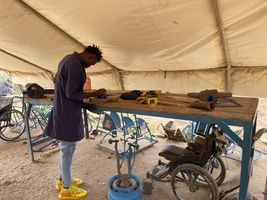When Andrew was younger, he saw someone wearing a prosthesis. “I was captivated,” he recalls. “I wanted to know how it was made.” He turned his fascination into a career, learning how to make and fit artificial limbs, braces and other assistance devices. In December 2021, he joined Humanity & Inclusion (HI) to work with refugees and host communities in Kakuma. “I had not done humanitarian work before, but I was interested in working in that context,” he explains.
Daily life in the refugee camps
Andrew is one of 36 full-time Kenyan staff who live at HI’s compound at the refugee camp. Staff rotate through 8-week cycles at Kakuma, with 2-week breaks to visit home and decompress, before returning for another two months.
Andrew is the only full-time artificial limbs and braces officer working at the camp, which has a population of more than 240,000 people. He spends each day of the week visiting HI’s three rehabilitation centers that are spread throughout the refugee camp, as well as its facility in the nearby Kalobeyei settlement.
“The demand for our services is quite high,” Andrew explains. “I’m covering the four camps and host community. In a given week, I will only visit each place once.”
 Andrew does have the support of six technical aid workers—refugees who have been trained in basic fabrication and repair of mobility devices—who staff the workshop at each rehabilitation center. Each workshop includes a cabinet stocked with basic tools and supplies. Crutches of all sizes line the walls. Walkers, wheelchairs, orthopedic shoes, toilet seats, wooden scooters and other mobility devices can also be found.
Andrew does have the support of six technical aid workers—refugees who have been trained in basic fabrication and repair of mobility devices—who staff the workshop at each rehabilitation center. Each workshop includes a cabinet stocked with basic tools and supplies. Crutches of all sizes line the walls. Walkers, wheelchairs, orthopedic shoes, toilet seats, wooden scooters and other mobility devices can also be found.
Journey to fitting
Andrew and his team see people who have required amputations for a number of reasons: gunshot wounds, explosions, snake bites, road traffic accidents, diabetes.
The waiting list for artificial limbs and braces is long, and funding is limited. In an average year, Andrew explains that HI Kenya has the budget to provide new artificial limbs to 20-25 people, and braces—such as special shoes or leg braces—to around 85 people. The waiting process can take more than a year because artificial limbs must travel over 200 km to reach beneficiaries.
Provision of artificial limbs, braces and other assistive devices is based on a selection with emphasis on disability, gender and age.
“If fitting someone with a prosthesis will help them enroll in school, we will make them a priority,” Andrew explains.
These activities are made possible by the U.S. Department of State’s Bureau of Populations, Refugees, and Migration.


 Andrew does have the support of six technical aid workers—refugees who have been trained in basic fabrication and repair of mobility devices—who staff the workshop at each rehabilitation center. Each workshop includes a cabinet stocked with basic tools and supplies. Crutches of all sizes line the walls. Walkers, wheelchairs, orthopedic shoes, toilet seats, wooden scooters and other mobility devices can also be found.
Andrew does have the support of six technical aid workers—refugees who have been trained in basic fabrication and repair of mobility devices—who staff the workshop at each rehabilitation center. Each workshop includes a cabinet stocked with basic tools and supplies. Crutches of all sizes line the walls. Walkers, wheelchairs, orthopedic shoes, toilet seats, wooden scooters and other mobility devices can also be found.
